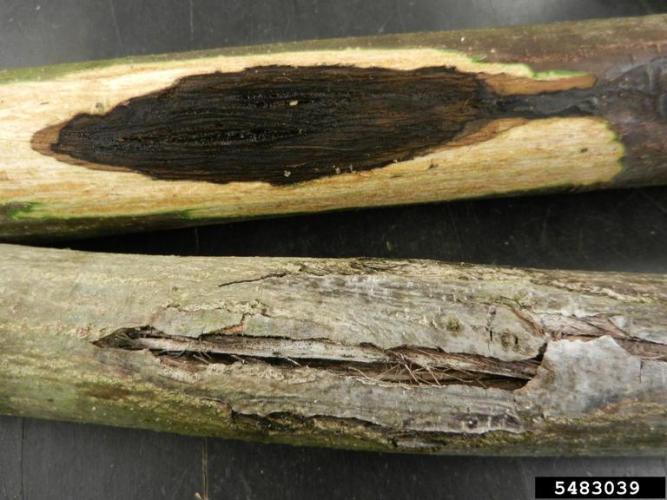Butternut Canker
Identification
Butternut canker is caused by a fungus (Sirococcus clavigignenti-juglandacearum) that infects butternut (Juglans cinerea) through openings such as buds, leaf scars, and insect wounds. Spores of the fungus enter the tree and create cankers that are elongated, sunken, often with an inky black center and whitish margin. When large cankers form (or many smaller cankers coalesce), twigs and branches become girdled, resulting in dieback. Trunk and buttress roots can also become girdled, ultimately killing the tree. The spores can be carried on the nuts and infect the tree upon germination. The fungus is spread by rain-splashed spores, wind, and insects. Spores can remain viable on dead trees for at least two years. Armillaria root rot is often associated with trees infected with butternut canker and may hasten mortality.
Signs and symptoms
• Dead or dying branches at the tops of butternut trees
• Cankers in the bark will ooze black fluid in the spring and have a dark center and whitish margin in the summer.
• Young cankers often appear around leaf scars, buds, or wounds and may be elongated and sunken into the bark.
• Old cankers may have layers of overgrown trunk tissue and loose bark covering them.
• Stained wood beneath the bark that is dark brown to black and oval shaped.
See image slideshow above for signs and symptoms.
Biology
Origin
Butternut canker was first discovered in the United States in Wisconsin in 1967. It is thought to have been introduced from abroad, although its native range and means of arrival in the US is unknown. Since its arrival 90% of the butternuts in the US have become infected throughout the tree’s native range.
Life Cycle
The disease is caused by a fungus that grows under the bark and produces thick, black hyphal pegs (or stomatal columns) that cause the bark to blister and split open. Asexual fruiting bodies, called pycnidia, are produced and released in gelatinous tendrils or creamy masses. Fruiting bodies are more likely to develop on dead branches than on cankered areas of the stem. Spores are moved by rain, wind, insects, birds, and rodents throughout the growing season.
threat
In late stages of the disease, multiple cankers will form on the branches, stem, and roots. The infected tree will stop producing nuts. The cankers grow and join together, killing the affected branches. If the cankers girdle the stem, the tree will die. Cankers also serve as entry points for other pathogenic and decay organisms.
Vermont Distribution
Butternut canker has spread throughout Vermont.
Citations
Photo Credit
Joseph OBrien, USDA Forest Service, Bugwood.org
Mike Ostry, United States Department of Agriculture, Forest Service, Bugwood.org
Tom Creswell, Purdue University, Bugwood.org
USDA Forest Service, Northeastern Area, USDA Forest Service, Bugwood.org
Manfed Mielke, USDA Forest Service, Bugwood.org
information credit
New York Times: Protecting a Little-Known Tree From an Insidious Disease
Northern Woodlands: Saving the Butternut Tree
University of Vermont Forest Pathology: Butternut Canker Disease
US Forest Service: How to Identify Butternut Canker and Manage Butternut Trees






